DC Microgrids: Benefits, Architectures, Perspectives and Challenges
Abstract
1. Introduction
2. Architectures and Configurations
- Single bus topology. This topology is the simplest topology since it is constituted by a single DC bus. Due to that, all generators, storage systems and loads will be connected to the same point (bus). Figure 1 shows two typical examples of this topology, with one being a connection to the electrical grid and the other one being an operation in islanded mode. Besides its simplicity, this topology is also characterized by low maintenance requirements, as well as low costs.
- Radial topology. This topology can be considered as an extension of the single bus. As shown in Figure 2, this topology provides more than one DC bus where each of them are used to connect generators, storage systems and loads. Typically, there are two possible configurations: series and parallel. In the first configuration, two or more DC microgrids can be interconnected in series (Figure 2a), while the other one is interconnected in parallel (Figure 2b). This topology still maintains some simplicity and allows for different voltage levels. Additionally, this topology increases reliability. However, one problem that can appear is some instability during the islanding mode [24,25,26,27].
- Ring or loop topology. In this topology, all generators, storage systems and loads will be connected to the same DC bus in a loop way to allow the supply through two sides (Figure 3). Due to this, this kind of topology becomes more reliable when compared with the previous configurations, since in the case of a fault in the DC bus, it is possible to operate in a single bus configuration, and the main problem of this topology is its increased complexity.
- Mesh topology. This topology is characterized by the possibility of including integrate ring (or rings) with radial topologies with a mesh configuration originating in this way (Figure 4). It is characterized by a complex structure that allows for better reliability and flexibility when compared with the previous ones.
- Interconnected topology. The previous topologies were characterized by a single connection to the AC main grid. Thus, in order to improve the reliability of the system, there is also the possibility to connect it to alternative AC grids (two or more), meaning this topology is designated by interconnections. In Figure 5, an example of this kind of topology, in which the DC microgrid is interconnected to two AC grid supplies, is presented.
- Unipolar configuration. This configuration is the simplest one since it is constituted by only two wires. In this configuration, all the generators, loads and storage systems will be connected to the same poles. In Figure 6, two typical examples of this topology are shown, whereby one has a connection to the grid and the other one operates in island mode.
- Bipolar configuration. This configuration is more complex since it is constituted by three wires (a positive pole, neutral pole and negative pole). In this configuration, there are different possibilities to connect the generators, loads and storage system. In fact, they can be connected to different poles (positive and neutral, neutral and positive or to the three poles). It also allows this equipment to be connected to different voltages, namely between the positive and negative pole or one of the poles and the neutral pole. Examples of this type of configuration can be seen in Figure 7, where one has a connection to the grid and the other one is operating in island mode.
3. Benefits
- The fact that the decentralized generators essentially produce DC power. Thus, the direct connection of these generators to the grid without the need to introduce a new converter (DC/AC) allows for the improvement of the efficiency of the system;
- The importance of storage systems in the context of the decentralized and renewable energy sources. As in the case of the generators, these storage systems (such as batteries) typically also produce and receive DC power, by which their direct integration in the distribution system also allows for the improvement of the efficiency of the global system;
- The fact that the electronic loads are usually supplied by a DC voltage source, by which they can be directly connected to the distribution grid. Most loads require a rectifier in order to provide the required DC voltage source;
- The predicted proliferation of electric vehicles requires a connection to the electrical grids to charge their batteries. Thus, the possibility of directly connecting the electric vehicle to the grid to avoid the rectifier can also improve the efficiency of the global system;
- The reduction in power quality problems that typically affect AC grids. In fact, problems such as voltage sags and swells, flickering, harmonics and imbalances that usually affect AC grids can be avoided in these DC microgrids;
- The lack of requirements about synchronization with the utility grid, as well as reactive power;
- The inexistence of skin effect, by which there will be an entire distribution of the current through the distribution cable. Due to this, there will be a reduction in the losses or the use of smaller section cables;
- The possibility to improve the reliability due to a high capacity to operate in island mode.
4. Perspectives
5. Challenges
6. Conclusions
Author Contributions
Funding
Institutional Review Board Statement
Informed Consent Statement
Data Availability Statement
Conflicts of Interest
References
- Zubieta, L.E. Are Microgrids the Future of Energy? DC Microgrids from Concept to Demonstration to Deployment. IEEE Electrif. Mag. 2016, 4, 37–44. [Google Scholar] [CrossRef]
- Fotopoulou, M.; Rakopoulos, D.; Trigkas, D.; Stergiopoulos, F.; Blanas, O.; Voutetakis, S. State of the Art of Low and Medium Voltage Direct Current (DC) Microgrids. Energies 2021, 14, 5595. [Google Scholar] [CrossRef]
- Fernández, G.; Galan, N.; Marquina, D.; Martínez, D.; Sanchez, A.; López, P.; Bludszuweit, H.; Rueda, J. Photovoltaic Generation Impact Analysis in Low Voltage Distribution Grids. Energies 2020, 13, 4347. [Google Scholar] [CrossRef]
- Moret, F.; Pinson, P. Energy Collectives: A Community and Fairness Based Approach to Future Electricity Markets. IEEE Trans. Power Syst. 2019, 34, 3994–4004. [Google Scholar] [CrossRef]
- Rodríguez-Molina, J.; Martínez-Núñez, M.; Martínez, J.-F.; Pérez-Aguiar, W. Business Models in the Smart Grid: Challenges, Opportunities and Proposals for Prosumer Profitability. Energies 2014, 7, 6142–6171. [Google Scholar] [CrossRef]
- Arboleya, P.; Koirala, A.; Suárez, L.; Mohamed, B.; González-Morán, C. Impact Evaluation of the New Self-Consumption Spanish Scenario on the Low-Voltage Terminal Distribution Network. IEEE Trans. Ind. Appl. 2019, 55, 7230–7239. [Google Scholar] [CrossRef]
- Schick, C.; Klempp, N.; Hufendiek, K. Impact of Network Charge Design in an Energy System with Large Penetration of Renewables and High Prosumer Shares. Energies 2021, 14, 6872. [Google Scholar] [CrossRef]
- Tushar, W.; Saha, T.K.; Yuen, C.; Smith, D.; Poor, H.V. Peer-to-Peer Trading in Electricity Networks: An Overview. IEEE Trans. Smart Grid 2020, 11, 3185–3200. [Google Scholar] [CrossRef]
- Lainfiesta Herrera, M.; Hayajneh, H.S.; Zhang, X. DC Communities: Transformative Building Blocks of the Emerging Energy Infrastructure. Energies 2021, 14, 7730. [Google Scholar] [CrossRef]
- Mackay, L.; Hailu, T.; Ramirez-Elizondo, L.; Bauer, P. Towards a DC distribution system—Opportunities and challenges. In Proceedings of the IEEE First International Conference on DC Microgrids (ICDCM), Atlanta, GA, USA, 7–10 June 2015; pp. 215–220. [Google Scholar] [CrossRef]
- Castillo-Calzadilla, T.; Cuesta, M.A.; Olivares-Rodriguez, C.; Macarulla, A.M.; Legarda, J.; Borges, C.E. Is it feasible a massive deployment of low voltage direct current microgrids renewable-based? A technical and social sight. Renew. Sustain. Energy Rev. 2022, 161, 112198. [Google Scholar] [CrossRef]
- Planas, E.; Andreu, J.; Gárate, J.I.; Alegría, I.M.; Ibarra, E. AC and DC technology in microgrids: A review. Renew. Sustain. Energy Rev. 2015, 43, 726–749. [Google Scholar] [CrossRef]
- Azeem, O.; Ali, M.; Abbas, G.; Uzair, M.; Qahmash, A.; Algarni, A.; Hussain, M.R. A Comprehensive Review on Integration Challenges, Optimization Techniques and Control Strategies of Hybrid AC/DC Microgrid. Appl. Sci. 2021, 11, 6242. [Google Scholar] [CrossRef]
- Nguyen, T.H.; Van, T.L.; Nawaz, A.; Natsheh, A. Feedback Linearization-Based Control Strategy for Interlinking Inverters of Hybrid AC/DC Microgrids with Seamless Operation Mode Transition. Energies 2021, 14, 5613. [Google Scholar] [CrossRef]
- Pires, V.F.; Foito, D.; Cordeiro, A.; Roncero-Clemente, C.; Martins, J.F.; Pires, A.J. Interlink Converter for Hybrid AC to Bipolar DC Microgrid or to Two DC Microgrids. In Proceedings of the 48th Annual Conference of the IEEE Industrial Electronics Society, Brussels, Belgium, 17–20 October 2022; pp. 1–6. [Google Scholar] [CrossRef]
- Bharatee, A.; Ray, P.K.; Subudhi, B.; Ghosh, A. Power Management Strategies in a Hybrid Energy Storage System Integrated AC/DC Microgrid: A Review. Energies 2022, 15, 7176. [Google Scholar] [CrossRef]
- Dragicevic, T.; Lu, X.; Vasquez, J.C.; Guerrero, J.M. DC Microgrids-Part II: A Review of Power Architectures, Applications, and Standardization Issues. IEEE Trans. Power Electron. 2016, 31, 3528–3549. [Google Scholar] [CrossRef]
- Kumar, D.; Zare, F.; Ghosh, A. DC Microgrid Technology: System Architectures, AC Grid Interfaces, Grounding Schemes, Power Quality, Communication Networks, Applications, and Standardizations Aspects. IEEE Access 2017, 5, 12230–12256. [Google Scholar] [CrossRef]
- Rodriguez-Diaz, E.; Chen, F.; Vasquez, J.C.; Guerrero, J.M.; Burgos, R.; Boroyevich, D. Voltage-Level Selection of Future Two-Level LVdc Distribution Grids: A Compromise Between Grid Compatibiliy, Safety, and Efficiency. Electrif. Mag. 2016, 4, 20–28. [Google Scholar] [CrossRef]
- Rai, I.; Ravishankar, S.; Anand, R. Review of DC Microgrid system with Various Power Quality Issues in “Real Time Operation of DC Microgrid Connected System. Majlesi J. Mechatron. Syst. 2020, 8, 35–44. [Google Scholar]
- Javed, W.; Chen, D.; Farrag, M.E.; Xu, Y. System Configuration, Fault Detection, Location, Isolation and Restoration: A Review on LVDC Microgrid Protections. Energies 2019, 12, 1001. [Google Scholar] [CrossRef]
- Bhargavi, K.M.; Jayalakshmi, N.S.; Gaonkar, D.N.; Shrivastava, A.; Jadoun, V.K. A comprehensive review on control techniques for power management of isolated DC microgrid system operation. IEEE Access 2021, 9, 32196–32228. [Google Scholar] [CrossRef]
- Rawat, G.S. Survey on DC microgrid architecture, power quality issues and control strategies. In Proceedings of the 2nd International Conference on Inventive Systems and Control (ICISC), Coimbatore, India, 19–20 January 2018; pp. 500–505. [Google Scholar] [CrossRef]
- Siad, S.B.; Iovine, A.; Damm, G.; Galai-Dol, L.; Netto, M. Nonlinear Hierarchical Easy-to-Implement Control for DC MicroGrids. Energies 2022, 15, 969. [Google Scholar] [CrossRef]
- Thounthong, P.; Mungporn, P.; Pierfederici, S.; Guilbert, D.; Bizon, N. Adaptive Control of Fuel Cell Converter Based on a New Hamiltonian Energy Function for Stabilizing the DC Bus in DC Microgrid Applications. Mathematics 2020, 8, 2035. [Google Scholar] [CrossRef]
- Shahid, M.U.; Khan, M.M.; Hashmi, K.; Habib, S.; Jiang, H.; Tang, H. A Control Methodology for Load Sharing System Restoration in Islanded DC Micro Grid with Faulty Communication Links. Electronics 2018, 7, 90. [Google Scholar] [CrossRef]
- Mohamad, A.M.E.I.; Mohamed, Y.A.-R.I. Investigation and Assessment of Stabilization Solutions for DC Microgrid With Dynamic Loads. IEEE Trans. Smart Grid 2019, 10, 5735–5747. [Google Scholar] [CrossRef]
- Hatahet, W.; Marei, M.I.; Mokhtar, M. Adaptive Controllers for Grid-Connected DC Microgrids. Int. J. Electr. Power Energy Syst. 2021, 130, 106917. [Google Scholar] [CrossRef]
- Liu, Z.; Zhao, J.; Zou, Z. Impedance Modeling, Dynamic Analysis and Damping Enhancement for DC Microgrid with Multiple Types of Loads. Int. J. Electr. Power Energy Syst. 2020, 122, 106183. [Google Scholar] [CrossRef]
- Singh, P.; Lather, J.S. Power Management and Control of a Grid-Independent DC Microgrid with Hybrid Energy Storage System. Sustain. Energy Technol. Assess. 2021, 43, 100924. [Google Scholar] [CrossRef]
- Bayati, N.; Baghaee, H.R.; Hajizadeh, A.; Soltani, M. Localized Protection of Radial DC Microgrids With High Penetration of Constant Power Loads. IEEE Syst. J. 2021, 15, 4145–4156. [Google Scholar] [CrossRef]
- Nasir, M.; Iqbal, S.; Khan, H.A.; Vasquez, J.C.; Guerrero, J.M. Sustainable Rural Electrification Through Solar PV DC Microgrids—An Architecture-Based Assessment. Processes 2020, 8, 1417. [Google Scholar] [CrossRef]
- Silveira, R.D.; Silva, S.A.O.; Sampaio, L.P. Dynamic Modeling and Stability Analysis of Radial and Ring DC Microgrid Topologies. In Proceedings of the Brazilian Power Electronics Conference (COBEP), Pessoa, Brazil, 7–10 November 2021; pp. 1–8. [Google Scholar] [CrossRef]
- Yu, H.; Niu, S.; Zhang, Y.; Jian, L. An Integrated and Reconfigurable Hybrid AC/DC Microgrid Architecture with Autonomous Power Flow Control for Nearly/Net Zero Energy Buildings. Appl. Energy 2020, 263, 114610. [Google Scholar] [CrossRef]
- Asad, R.; Kazemi, A. A Novel Distributed Optimal Power Sharing Method for Radial Dc Microgrids with Different Distributed Energy Sources. Energy 2014, 72, 291–299. [Google Scholar] [CrossRef]
- Mohanty, R.; Pradhan, A.K. Protection of Smart DC Microgrid With Ring Configuration Using Parameter Estimation Approach. IEEE Trans. Smart Grid 2018, 9, 6328–6337. [Google Scholar] [CrossRef]
- Li, M.; Zhang, D.; Lu, S.; Tang, X.; Phung, T. Differential Evolution-Based Overcurrent Protection for DC Microgrids. Energies 2021, 14, 5026. [Google Scholar] [CrossRef]
- Bayati, N.; Hajizadeh, A.; Soltani, M. Localized Fault Protection in the DC Microgrids with Ring Configuration. In Proceedings of the IEEE 28th International Symposium on Industrial Electronics (ISIE), Vancouver, BC, Canada, 12–14 June 2019; pp. 136–140. [Google Scholar] [CrossRef]
- Wakode, S.A.; Sheikh, A.A.; Deshmukh, R.R.; Ballal, M.S. Oscillation Frequency Based Protection Scheme for Ring Type DC Microgrid. In Proceedings of the IEEE International Conference on Power Electronics, Smart Grid and Renewable Energy (PESGRE2020), Cochin, India, 2–4 January 2020; pp. 1–5. [Google Scholar] [CrossRef]
- Sallam, A.M.; Ahmed, H.M.A.; Salama, M.M.A. A Planning Framework for AC-DC Bilayer Microgrids. Electr. Power Syst. Res. 2020, 188, 106524. [Google Scholar] [CrossRef]
- Chakraborty, C.; Iu, H.H.C.; Lu, D.D.C. Power converters, control, and energy management for distributed generation. IEEE Trans. Ind. Electron. 2015, 62, 4466–4470. [Google Scholar] [CrossRef]
- Lee, G.-Y.; Ko, B.-S.; Lee, J.-S.; Kim, R.-Y. An Off-Line Design Methodology of Droop Control for Multiple Bi-Directional Distributed Energy Resources Based on Voltage Sensitivity Analysis in DC Microgrids. Int. J. Electr. Power Energy Syst. 2020, 118, 105754. [Google Scholar] [CrossRef]
- Feng, X.; Butler-Purry, K.L.; Zourntos, T. Real-Time Electric Load Management for DC Zonal All-Electric Ship Power Systems. Electr. Power Syst. Res. 2018, 154, 503–514. [Google Scholar] [CrossRef]
- Ciezki, J.G.; Ashton, R.W. Selection and Stability Issues Associated with a Navy Shipboard DC Zonal Electric Distribution System. IEEE Trans. Power Deliv. 2000, 15, 665–669. [Google Scholar] [CrossRef]
- Kakigano, H.; Miura, Y.; Ise, T. Low-voltage bipolar-type DC microgrid for super high quality distribution. IEEE Trans. Power Electron. 2010, 25, 3066–3075. [Google Scholar] [CrossRef]
- Rivera, S.; Lizana, R.; Kouro, F.S.; Dragičević, T.; Wu, B. Bipolar DC Power Conversion: State-of-the-Art and Emerging Technologies. IEEE J. Emerg. Sel. Top. Power Electron. 2021, 9, 1192–1204. [Google Scholar] [CrossRef]
- Pires, V.F.; Cordeiro, A.; Roncero-Clemente, C.; Rivera, S.; Dragičević, T. DC-DC Converters for Bipolar Microgrid Voltage Balancing: A Comprehensive Review of Architectures and Topologies. IEEE J. Emerg. Sel. Top. Power Electron. 2022. [Google Scholar] [CrossRef]
- Montoya, O.D.; Gil-González, W.; Grisales-Noreña, L.F. Solar Photovoltaic Integration in Monopolar DC Networks via the GNDO Algorithm. Algorithms 2022, 15, 277. [Google Scholar] [CrossRef]
- Srivastava, C.; Tripathy, M.; Wang, L. Fault Detection and Classification of DC Microgrid Utilizing Differential Protection Scheme. In Proceedings of the IEEE IAS Global Conference on Emerging Technologies (GlobConET), Arad, Romania, 20–22 May 2022; pp. 96–101. [Google Scholar] [CrossRef]
- Wang, T.; Monti, A. Fault Detection and Isolation in DC Microgrids Based on Singularity Detection in the Second Derivative of Local Current Measurement. IEEE J. Emerg. Sel. Top. Power Electron. 2021, 9, 2574–2588. [Google Scholar] [CrossRef]
- Peng, Y.; Song, Z.; Zeng, X.; Pan, Z.; Zhang, S.; Shen, X.; Wang, L. Fast protection strategy for monopole grounding fault of low-voltage DC microgrid. Electr. Power Syst. Res. 2023, 214, 108919. [Google Scholar] [CrossRef]
- Prabhakaran, P.; Agarwal, V. Novel Four-port DC–DC converter for interfacing solar PV–fuel cell hybrid sources with low-voltage bipolar DC microgrids. IEEE J. Emerg. Sel. Top. Power Electron. 2020, 8, 1330–1340. [Google Scholar] [CrossRef]
- Lee, J.; Kim, Y.; Jeon, J. Optimal power flow for bipolar DC microgrids. Int. J. Electr. Power Energy Syst. 2022, 142, 108375. [Google Scholar] [CrossRef]
- Guo, C.; Wang, Y.; Liao, J. Coordinated Control of Voltage Balancers for the Regulation of Unbalanced Voltage in a Multi-Node Bipolar DC Distribution Network. Electronics 2022, 11, 166. [Google Scholar] [CrossRef]
- Doubabi, H.; Salhi, I.; Essounbouli, N. A Novel Control Technique for Voltage Balancing in Bipolar DC Microgrids. Energies 2022, 15, 3368. [Google Scholar] [CrossRef]
- Wang, F.; Lei, Z.; Xu, X.; Shu, X. Topology Deduction and Analysis of Voltage Balancers for DC Microgrid. IEEE J. Emerg. Sel. Top. Power Electron. 2017, 5, 672–680. [Google Scholar] [CrossRef]
- Wang, R.; Feng, W.; Xue, H.; Gerber, D.; Li, Y.; Hao, B.; Wang, Y. Simulation and power quality analysis of a Loose-Coupled bipolar DC microgrid in an office building. Appl. Energy 2021, 303, 117606. [Google Scholar] [CrossRef]
- Sepúlveda-García, S.; Montoya, O.D.; Garcés, A. Power Flow Solution in Bipolar DC Networks Considering a Neutral Wire and Unbalanced Loads: A Hyperbolic Approximation. Algorithms 2022, 15, 341. [Google Scholar] [CrossRef]
- Lee, J.-O.; Kim, Y.-S.; Moon, S.-I. Current Injection Power Flow Analysis and Optimal Generation Dispatch for Bipolar DC Microgrids. IEEE Trans. Smart Grid 2021, 12, 1918–1928. [Google Scholar] [CrossRef]
- Gerber, D.L.; Vossos, V.; Feng, W.; Marnay, C.; Nordman, B.; Brown, R. A simulation-based efficiency comparison of AC and DC power distribution networks in commercial buildings. Appl. Energy 2018, 210, 1167–1187. [Google Scholar] [CrossRef]
- Aljafari, B.; Vasantharaj, S.; Indragandhi, V.; Vaibhav, R. Optimization of DC, AC, and Hybrid AC/DC Microgrid-Based IoT Systems: A Review. Energies 2022, 15, 6813. [Google Scholar] [CrossRef]
- Justo, J.J.; Mwasilu, F.; Lee, J.; Jung, J. AC-microgrids versus DC-microgrids with distributed energy resources: A review. Renew. Sustain. Energy Rev. 2013, 24, 387–405. [Google Scholar] [CrossRef]
- El-Shahat, A.; Sumaiya, S. DC-Microgrid System Design, Control, and Analysis. Electronics 2019, 8, 124. [Google Scholar] [CrossRef]
- Zuluaga-Ríos, C.D.; Villa-Jaramillo, A.; Saldarriaga-Zuluaga, S.D. Evaluation of Distributed Generation and Electric Vehicles Hosting Capacity in Islanded DC Grids Considering EV Uncertainty. Energies 2022, 15, 7646. [Google Scholar] [CrossRef]
- Aggeler, D.; Canales, F.; Zelaya-De La Parra, H.; Coccia, A.; Butcher, N.; Apeldoorn, O. Ultra-Fast DC-Charge Infrastructures for EV-Mobility and Future Smart Grids. In Proceedings of the 2010 IEEE PES Innovative Smart Grid Technologies Conference, Gothenburg, Sweden, 11–13 October 2010; pp. 1–8. [Google Scholar]
- Sospiro, P.; Amarnath, L.; Di Nardo, V.; Talluri, G.; Gandoman, F.H. Smart Grid in China, EU, and the US: State of Implementation. Energies 2021, 14, 5637. [Google Scholar] [CrossRef]
- Pires, V.; Roque, A.; Sousa, D.M.; Marques, G. Photovoltaic Electric Vehicle Chargers as a Support for Reactive Power Compensation. In Proceedings of the International Conference on Renewable Energy Research and Applications, Nagasaki, Japan, 11–14 November 2014; pp. 1–6. [Google Scholar]
- Li, M.; Liu, Y.; Yue, W. Evolutionary Game of Actors in China’s Electric Vehicle Charging Infrastructure Industry. Energies 2022, 15, 8806. [Google Scholar] [CrossRef]
- Khan, S.; Ahmad, A.; Ahmad, F.; Shemami, M.S.; Alam, M.S.; Khateeb, S. A Comprehensive Review on Solar Powered Electric Vehicle Charging System. Smart Sci. 2018, 6, 54–79. [Google Scholar] [CrossRef]
- Rivera, S.; Wu, B. Electric Vehicle Charging Station with an Energy Storage Stage for Split-DC Bus Voltage Balancing. IEEE Trans. Power 2017, 32, 2376–2386. [Google Scholar] [CrossRef]
- Tan, L.; Wu, B.; Rivera, S.; Yaramasu, V. Comprehensive DC Power Balance Management in High-Power Three-Level DC–DC Converter for Electric Vehicle Fast Charging. IEEE Trans. Power Electron. 2016, 31, 89–100. [Google Scholar] [CrossRef]
- Savio Abraham, D.; Verma, R.; Kanagaraj, L.; Giri Thulasi Raman, S.R.; Rajamanickam, N.; Chokkalingam, B.; Marimuthu Sekar, K.; Mihet-Popa, L. Electric Vehicles Charging Stations’ Architectures, Criteria, Power Converters, and Control Strategies in Microgrids. Electronics 2021, 10, 1895. [Google Scholar] [CrossRef]
- Sun, B.; Dragičević, T.; Freijedo, F.D.; Vasquez, J.C.; Guerrero, J.M. A Control Algorithm for Electric Vehicle Fast Charging Stations Equipped With Flywheel Energy Storage Systems. IEEE Trans. Power Electron. 2016, 31, 6674–6685. [Google Scholar] [CrossRef]
- Kathiresan, J.; Natarajan, S.K.; Jothimani, G. Energy management of distributed renewable energy sources for residential DC microgrid applications. Int. Trans. Electr. Energy Syst. 2020, 30, e12258. [Google Scholar] [CrossRef]
- Oliveira, T.R.; Bolzon, A.S.; Donoso-Garcia, P.F. Grounding and safety considerations for residential DC microgrids. In Proceedings of the 40th Annual Conference of the IEEE Industrial Electronics Society, Dallas, TX, USA, 29 October–1 November 2014; pp. 5526–5532. [Google Scholar] [CrossRef]
- Al-Sakkaf, S.; Kassas, M.; Khalid, M.; Abido, M.A. An Energy Management System for Residential Autonomous DC Microgrid Using Optimized Fuzzy Logic Controller Considering Economic Dispatch. Energies 2019, 12, 1457. [Google Scholar] [CrossRef]
- Rodriguez-Diaz, E.; Savaghebi, M.; Vasquez, J.C.; Guerrero, J.M. An overview of low voltage DC distribution systems for residential applications. In Proceedings of the IEEE 5th International Conference on Consumer Electronics—Berlin (ICCE-Berlin), Berlin, Germany, 6–9 September 2015; pp. 318–322. [Google Scholar] [CrossRef]
- Padilla-Medina, A.; Perez-Pinal, F.; Jimenez-Garibay, A.; Vazquez-Lopez, A.; Martinez-Nolasco, J. Design and Implementation of an Energy-Management System for a Grid-Connected Residential DC Microgrid. Energies 2020, 13, 4074. [Google Scholar] [CrossRef]
- Zubieta, L.; Zhang, Y.; Bauer, D. Protection Scheme for a Residential DC Microgrid. In Proceedings of the IEEE Fourth International Conference on DC Microgrids (ICDCM), Arlington, VA, USA, 18–21 July 2021; pp. 1–7. [Google Scholar] [CrossRef]
- Kang, J.; Hao, B.; Li, Y.; Lin, H.; Xue, Z. The Application and Development of LVDC Buildings in China. Energies 2022, 15, 7045. [Google Scholar] [CrossRef]
- Vossos, V.; Gerber, D.L.; Gaillet-Tournier, M.; Nordman, B.; Brown, R.; Bernal Heredia, W.; Ghatpande, O.; Saha, A.; Arnold, G.; Frank, S.M. Adoption Pathways for DC Power Distribution in Buildings. Energies 2022, 15, 786. [Google Scholar] [CrossRef]
- Zhang, F.; Meng, C.; Yang, Y.; Sun, C.; Ji, C.; Chen, Y.; Wei, W.; Qiu, H.; Yand, G. Advantages and challenges of DC microgrid for commercial building a case study from Xiamen university DC microgrid. In Proceedings of the IEEE First International Conference on DC Microgrids (ICDCM), Atlanta, GA, USA, 7–10 June 2015; pp. 355–358. [Google Scholar] [CrossRef]
- Lowitzsch, J.; Hoicka, C.E.; van Tulder, F.J. Renewable energy communities under the 2019 European Clean Energy Package—Governance model for the energy clusters of the future? Renew. Sustain. Energy Rev. 2020, 122, 109489. [Google Scholar] [CrossRef]
- Trivedi, R.; Patra, S.; Sidqi, Y.; Bowler, B.; Zimmermann, F.; Deconinck, G.; Papaemmanouil, A.; Khadem, S. Community-Based Microgrids: Literature Review and Pathways to Decarbonise the Local Electricity Network. Energies 2022, 15, 918. [Google Scholar] [CrossRef]
- Nasir, M.; Khan, H.A.; Hussain, A.; Mateen, L.; Zaffar, N.A. Solar PV-Based Scalable DC Microgrid for Rural Electrification in Developing Regions. IEEE Trans. Sustain. Energy 2018, 9, 390–399. [Google Scholar] [CrossRef]
- Madduri, P.A.; Poon, J.; Rosa, J.; Podolsky, M.; Brewer, E.A.; Sanders, S.R. Scalable DC Microgrids for Rural Electrification in Emerging Regions. IEEE J. Emerg. Sel. Top. Power Electron. 2016, 4, 1195–1205. [Google Scholar] [CrossRef]
- Richard, L.; Boudinet, C.; Ranaivoson, S.A.; Rabarivao, J.O.; Befeno, A.E.; Frey, D.; Alvarez-Hérault, M.-C.; Raison, B.; Saincy, N. Development of a DC Microgrid with Decentralized Production and Storage: From the Lab to Field Deployment in Rural Africa. Energies 2022, 15, 6727. [Google Scholar] [CrossRef]
- Phurailatpam, C.; Rajpurohit, B.S.; Wang, L. Planning and optimization of autonomous DC microgrids for rural and urban applications in India. Renew. Sustain. Energy Rev. 2018, 82, 194–204. [Google Scholar] [CrossRef]
- Elsayed, A.T.; Mohamed, A.A.; Mohammed, O.A. DC microgrids and distribution systems: An overview. Electr. Power Syst. Res. 2015, 119, 407–417. [Google Scholar] [CrossRef]
- D’Agostino, F.; Kaza, D.; Martelli, M.; Schiapparelli, G.-P.; Silvestro, F.; Soldano, C. Development of a Multiphysics Real-Time Simulator for Model-Based Design of a DC Shipboard Microgrid. Energies 2020, 13, 3580. [Google Scholar] [CrossRef]
- Al Amerl, A.; Oukkacha, I.; Camara, M.B.; Dakyo, B. Real-Time Control Strategy of Fuel Cell and Battery System for Electric Hybrid Boat Application. Sustainability 2021, 13, 8693. [Google Scholar] [CrossRef]
- Shekhar, A.; Ramirez-Elizondo, L.; Bauer, P. DC Microgrid Islands on Ships. In Proceedings of the 2017 IEEE Second International Conference on DC Microgrids (ICDCM), Nuremburg, Germany, 27–29 June 2017; pp. 111–118. [Google Scholar]
- Faddel, S.; Saad, A.A.; Mohammed, O. Decentralized Energy Management of Hybrid Energy Storage on MVDC Shipboard Power System. In Proceedings of the 2018 IEEE Industry Applications Society Annual Meeting (IAS), Portland, OR, USA, 23–27 September 2018; pp. 1–7. [Google Scholar]
- Jayasinghe, S.G.; Meegahapola, L.; Fernando, N.; Jin, Z.; Guerrero, J.M. Review of Ship Microgrids: System Architectures, Storage Technologies and Power Quality Aspects. Inventions 2017, 2, 4. [Google Scholar] [CrossRef]
- Menicanti, S.; di Benedetto, M.; Marinelli, D.; Crescimbini, F. Recovery of Trains’ Braking Energy in a Railway Micro-Grid Devoted to Train plus Electric Vehicle Integrated Mobility. Energies 2022, 15, 1261. [Google Scholar] [CrossRef]
- Ceraolo, M.; Lutzemberger, G.; Meli, E.; Pugi, L.; Rindi, A.; Pancari, G. Energy storage systems to exploit regenerative-braking in DC railway systems; Different approaches to improve efficiency-of modern high-speed trains. J. Energy Storage 2018, 16, 269–279. [Google Scholar] [CrossRef]
- Verdicchio, A.; Ladoux, P.; Caron, H.; Courtois, C. New Medium-Voltage DC Railway Electrification System. IEEE Trans. Transp. Electrific. 2018, 4, 591–604. [Google Scholar] [CrossRef]
- Perez, F.; Iovine, A.; Damm, G.; Galai-Dol, L.; Ribeiro, P.F. Stability Analysis of a DC MicroGrid for a Smart Railway Station Integrating Renewable Sources. IEEE Trans. Control Syst. Technol. 2020, 28, 1802–1816. [Google Scholar] [CrossRef]
- Pratt, A.; Kumar, P.; Aldridge, T.V. Evaluation of 400V DC distribution in telco and data centers to improve energy efficiency. In Proceedings of the IEEE 29th International Telecommunication Energy Conference (INTELEC), Rome, Italy, 30 September–4 October 2007; pp. 32–39. [Google Scholar]
- AlLee, G.; Tschudi, W. Edison redux: 380 Vdc brings reliability and efficiency to sustainable data centers. IEEE Power Energy Mag. 2012, 10, 50–59. [Google Scholar] [CrossRef]
- Li, X.; Ji, Z.; Yang, F.; Dou, Z.; Zhang, C.; Chen, L. A Distributed Two-Level Control Strategy for DC Microgrid Considering Safety of Charging Equipment. Energies 2022, 15, 8600. [Google Scholar] [CrossRef]
- Mohammadi, J.; Ajaei, F.; Stevens, G. Grounding the DC Microgrid. IEEE Trans. Ind. Appl. 2019, 55, 4490–4499. [Google Scholar] [CrossRef]
- Lu, S.; Yu, T.; Liu, H.; Zhang, W.; Sui, Y.; Yang, J.; Zhang, L.; Zhou, J.; Wang, H. Research on Flexible Virtual Inertia Control Method Based on the Small Signal Model of DC Microgrid. Energies 2022, 15, 8360. [Google Scholar] [CrossRef]
- Li, C.; Yang, Y.; Dragicevic, T.; Blaabjerg, F. A New Perspective for Relating Virtual Inertia With Wideband Oscillation of Voltage in Low-Inertia DC Microgrid. IEEE Trans. Ind. Electron. 2022, 69, 7029–7039. [Google Scholar] [CrossRef]
- Mao, J.; Zhang, X.; Dai, T.; Wu, A.; Yin, C. An Adaptive Backstepping Sliding Mode Cascade-Control Method for a DC Microgrid Based on Nonlinear Virtual Inertia. Electronics 2021, 10, 3100. [Google Scholar] [CrossRef]
- Zhang, Y.; Sun, Q.; Zhou, J.; Li, L.; Wang, P.; Guerrero, J.M. Coordinated Control of Networked AC/DC Microgrids With Adaptive Virtual Inertia and Governor-Gain for Stability Enhancement. IEEE Trans. Energy Convers. 2021, 36, 95–110. [Google Scholar] [CrossRef]
- Wang, F.; Sun, L.; Wen, Z.; Zhuo, F. Overview of Inertia Enhancement Methods in DC System. Energies 2022, 15, 6704. [Google Scholar] [CrossRef]
- Yang, Y.; Li, C.; Xu, J.; Blaabjerg, F.; Dragičević, T. Virtual Inertia Control Strategy for Improving Damping Performance of DC Microgrid With Negative Feedback Effect. IEEE J. Emerg. Sel. Top. Power Electron. 2021, 9, 1241–1257. [Google Scholar] [CrossRef]
- Sarojini, R.K.; Palanisamy, K.; De Tuglie, E. A Fuzzy Logic-Based Emulated Inertia Control to a Supercapacitor System to Improve Inertia in a Low Inertia Grid with Renewables. Energies 2022, 15, 1333. [Google Scholar] [CrossRef]
- Zhu, X.; Meng, F.; Xie, Z.; Yue, Y. An Inertia and Damping Control Method of DC–DC Converter in DC Microgrids. IEEE Trans. Energy Convers. 2020, 35, 799–807. [Google Scholar] [CrossRef]
- Aluko, A.; Buraimoh, E.; Oni, O.E.; Davidson, I.E. Advanced Distributed Cooperative Secondary Control of Islanded DC Microgrids. Energies 2022, 15, 3988. [Google Scholar] [CrossRef]
- Pires, V.; Cordeiro, A.; Foito, D.; Silva, J. Control transition mode from voltage control to MPPT for PV generators in isolated DC microgrids. Int. J. Electr. Power Energy Syst. 2022, 137, 107876. [Google Scholar] [CrossRef]
- Meng, L.; Shafiee, Q.; Trecate, G.; Karimi, H.; Fulwani, D.; Lu, X.; Guerrero, J. Review on Control of DC Microgrids and Multiple Microgrid Clusters. IEEE J. Emerg. Sel. Top. Power Electron. 2017, 5, 928–948. [Google Scholar] [CrossRef]
- Al-Tameemi, Z.H.A.; Lie, T.T.; Foo, G.; Blaabjerg, F. Control Strategies of DC Microgrids Cluster: A Comprehensive Review. Energies 2021, 14, 7569. [Google Scholar] [CrossRef]
- Yang, Y.; Huang, C.; Xu, Q. A Fault Location Method Suitable for Low-Voltage DC Line. IEEE Trans. Power Deliv. 2020, 35, 194–204. [Google Scholar] [CrossRef]
- Hategekimana, P.; Ferre, A.J.; Bernuz, J.M.R.; Ntagwirumugara, E. Fault Detecting and Isolating Schemes in a Low-Voltage DC Microgrid Network from a Remote Village. Energies 2022, 15, 4460. [Google Scholar] [CrossRef]
- Seo, H.-C. Development of New Protection Scheme in DC Microgrid Using Wavelet Transform. Energies 2022, 15, 283. [Google Scholar] [CrossRef]
- Jithin, K.; Haridev, P.P.; Mayadevi, N.; Kumar, R.H.; Mini, V.P. A Review on Challenges in DC Microgrid Planning and Implementation. J. Mod. Power Syst. Clean Energy 2022, 1–21. [Google Scholar] [CrossRef]
- Kim, Y.-J.; Kim, H. Arc extinguishment for DC circuit breaker by PPTC device. In Proceedings of the IEEE International Conference on Industrial and Information Systems (ICIIS), Peradeniya, Sri Lanka, 15–16 December 2017; pp. 1–5. [Google Scholar] [CrossRef]
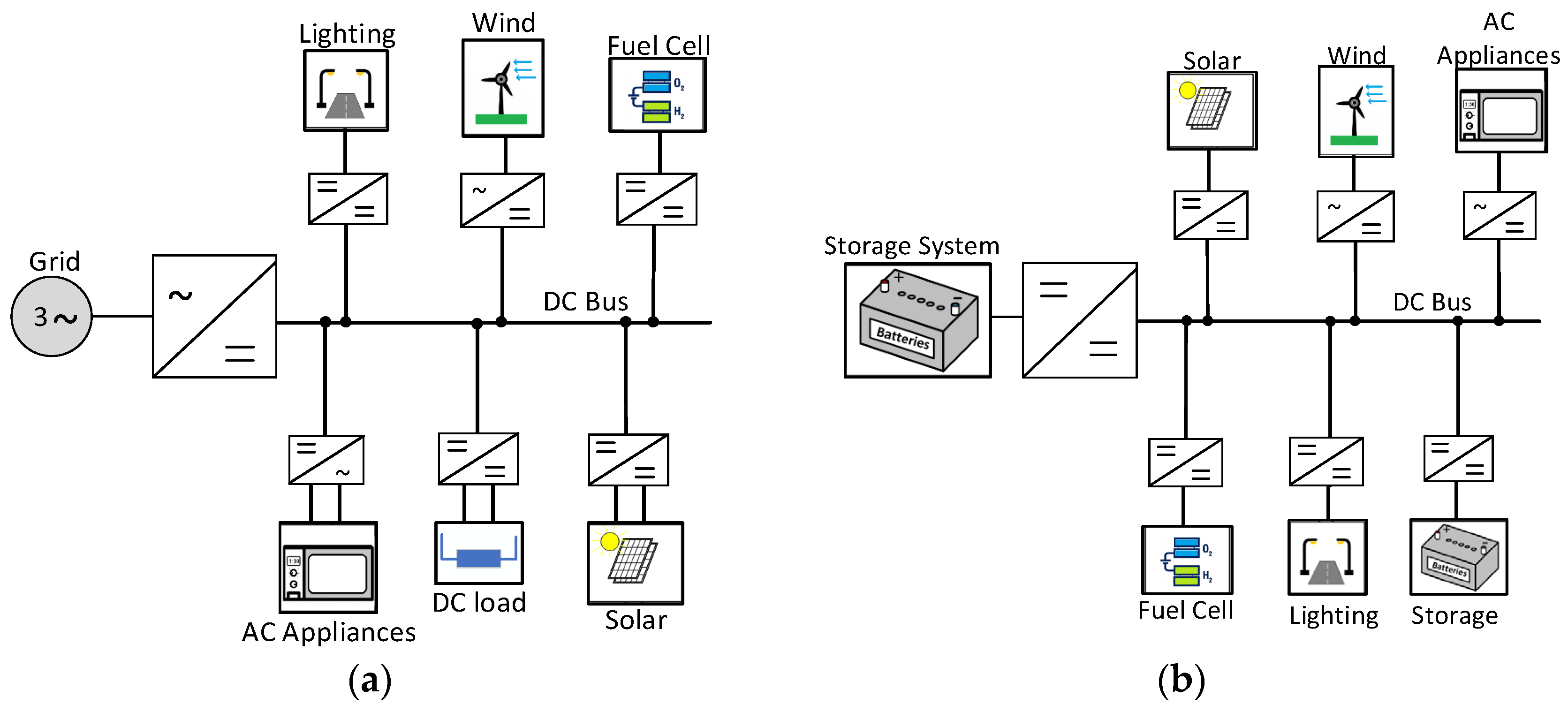


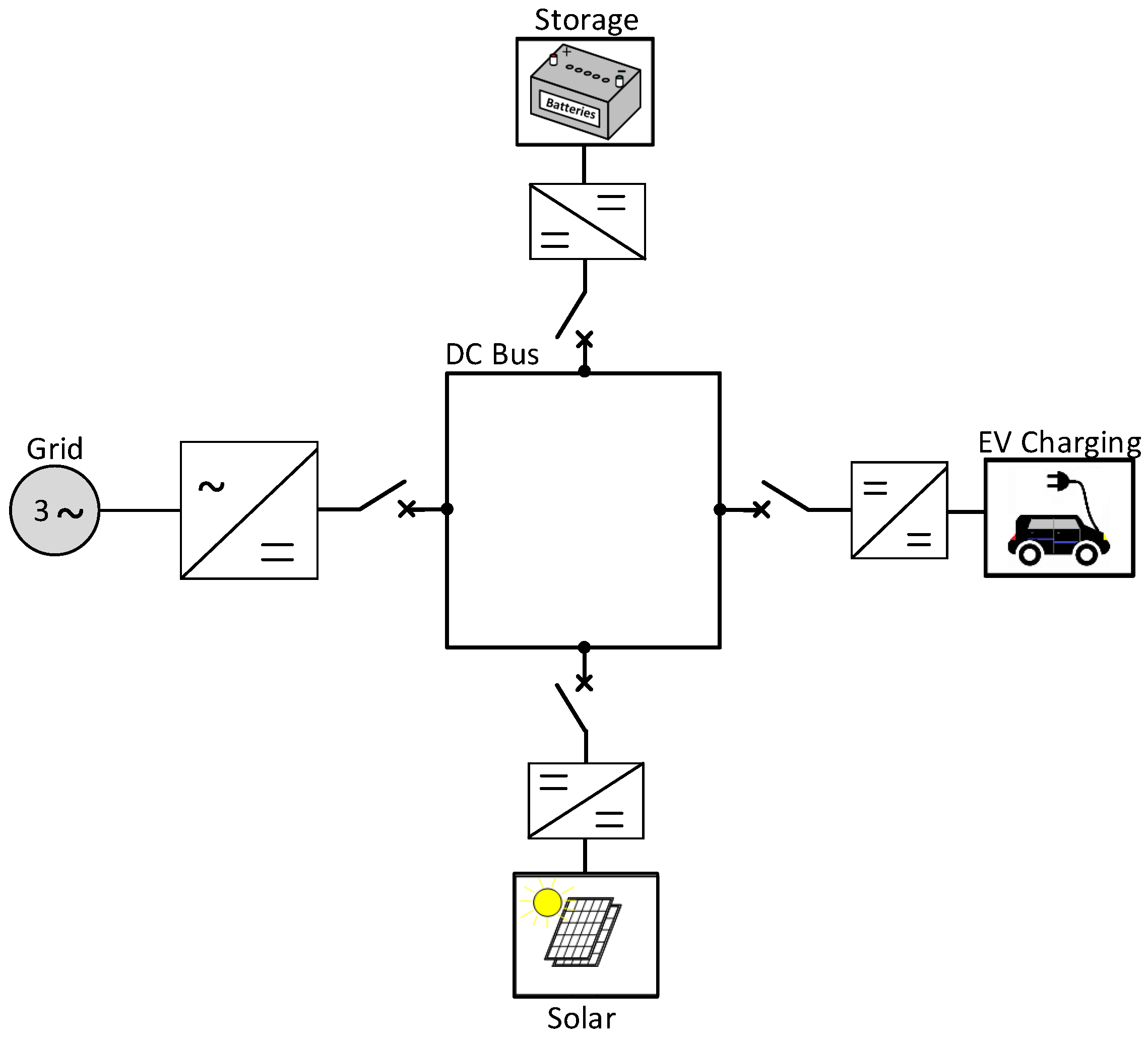
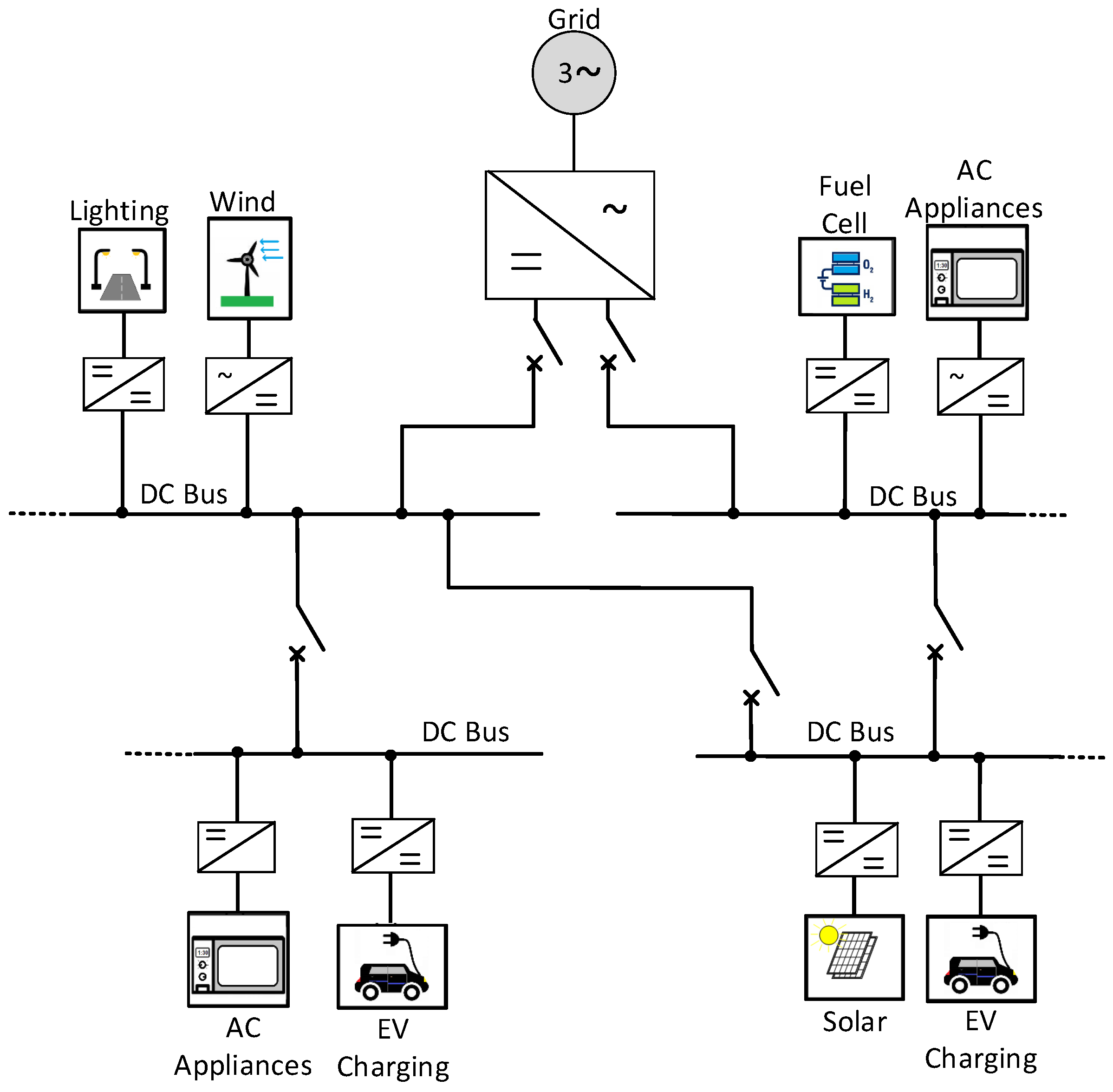

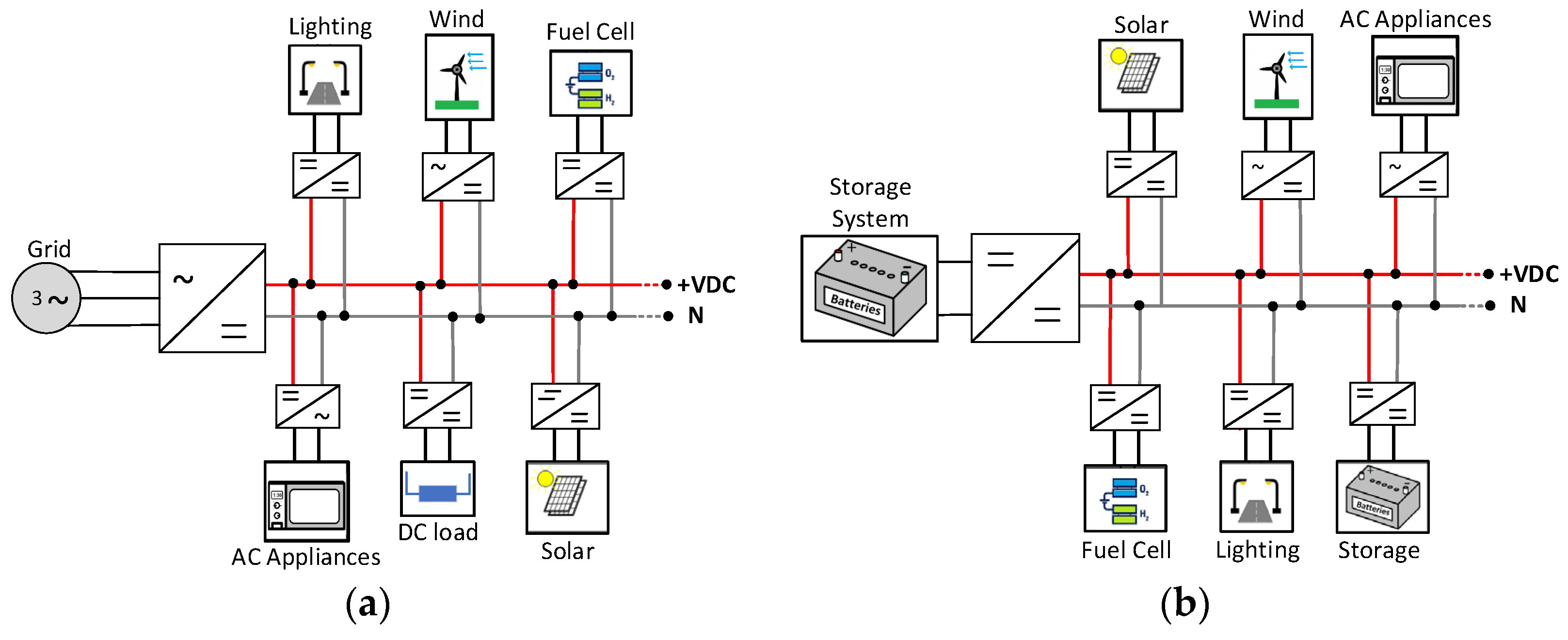




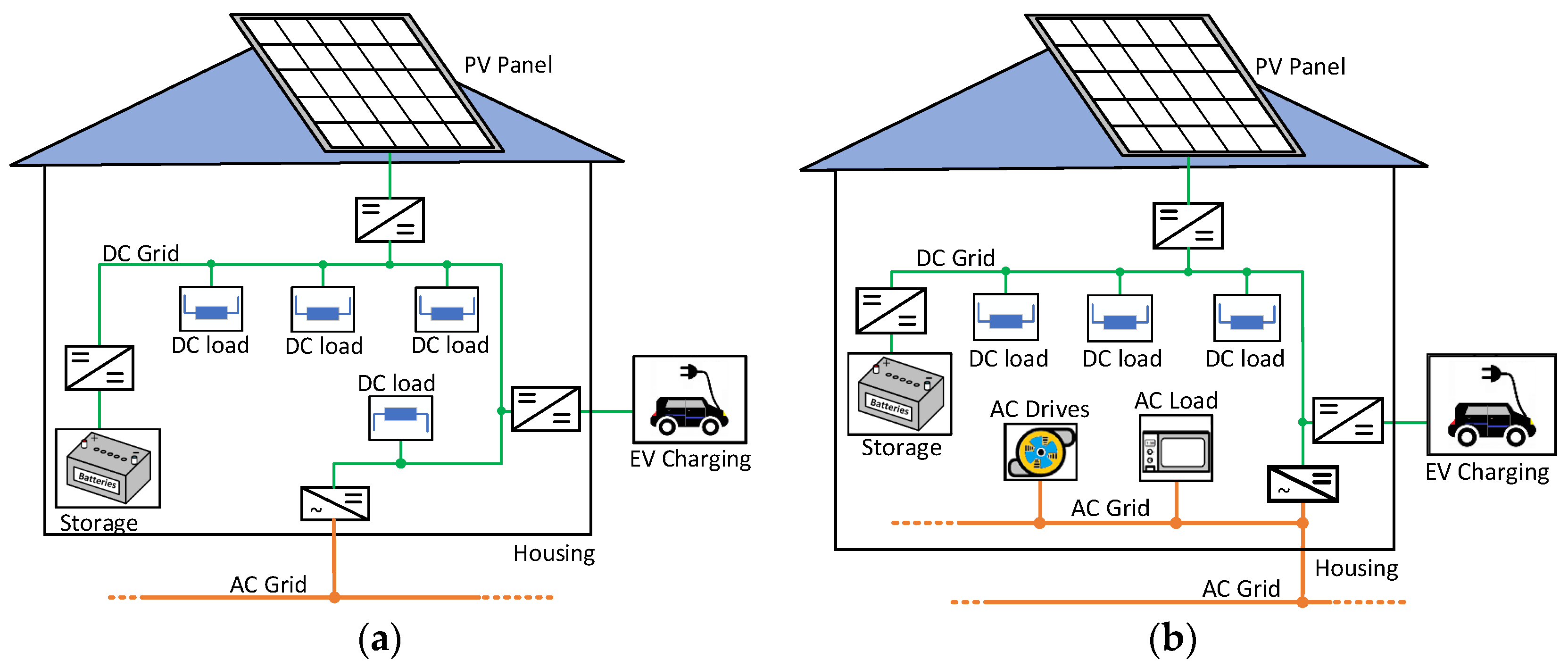
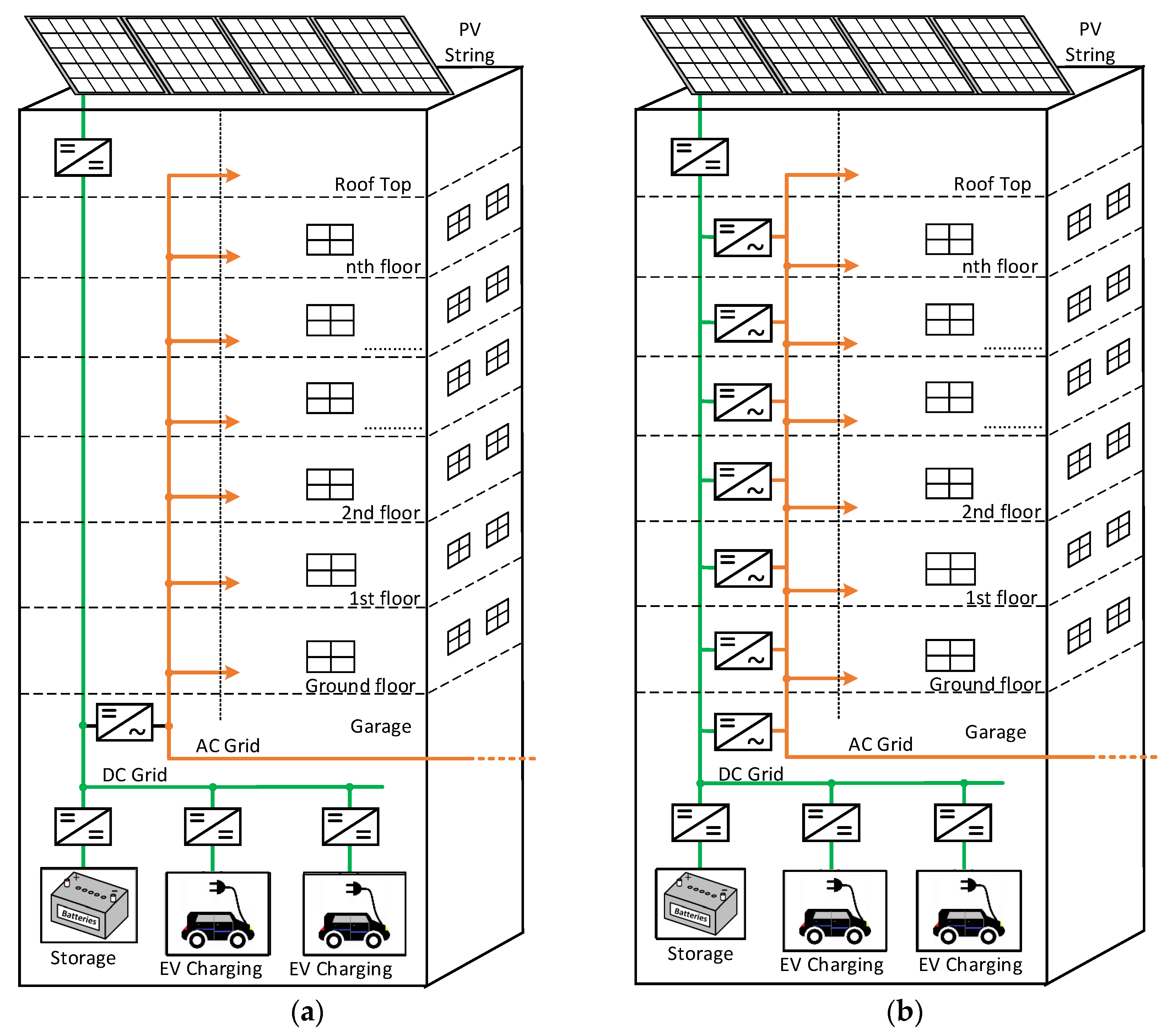
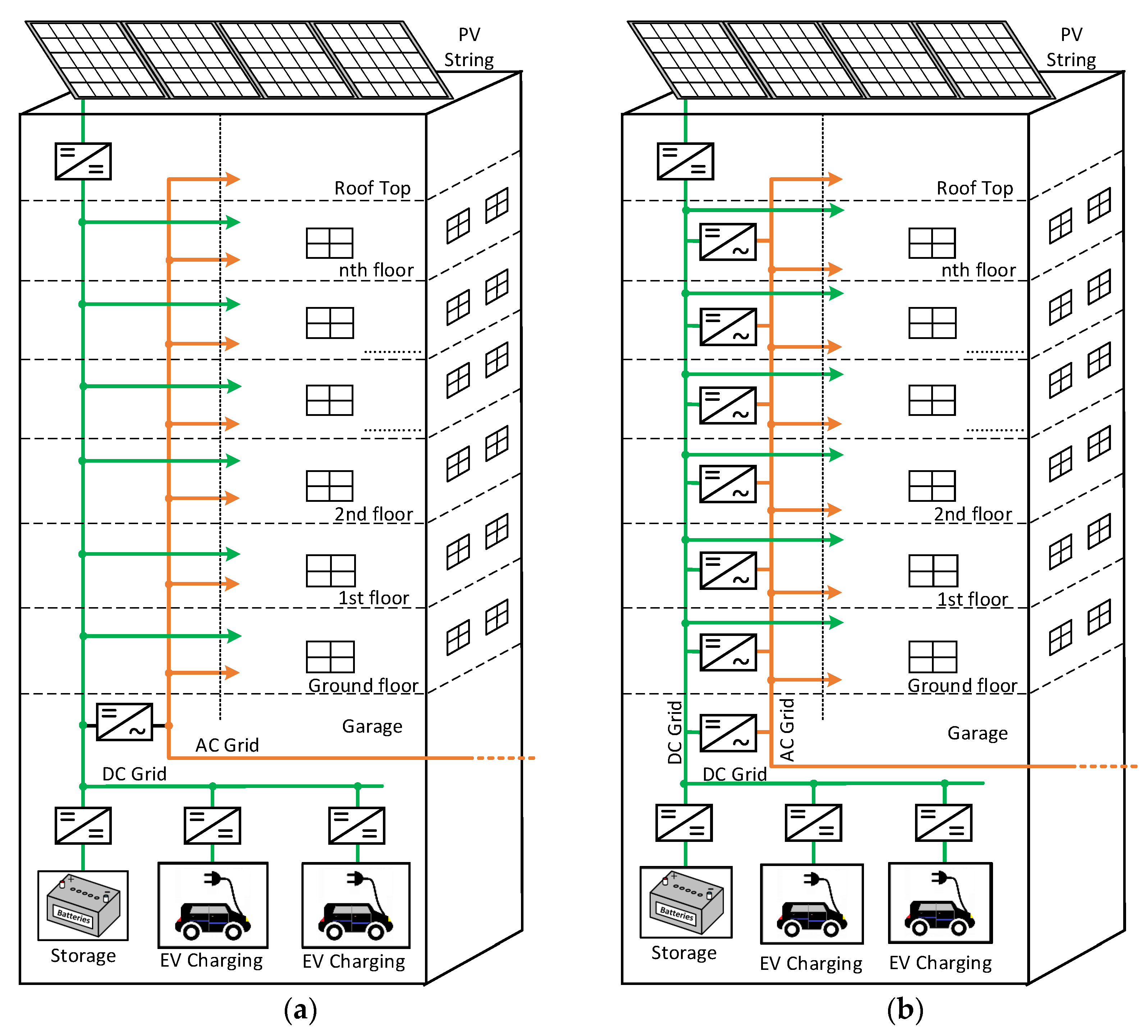
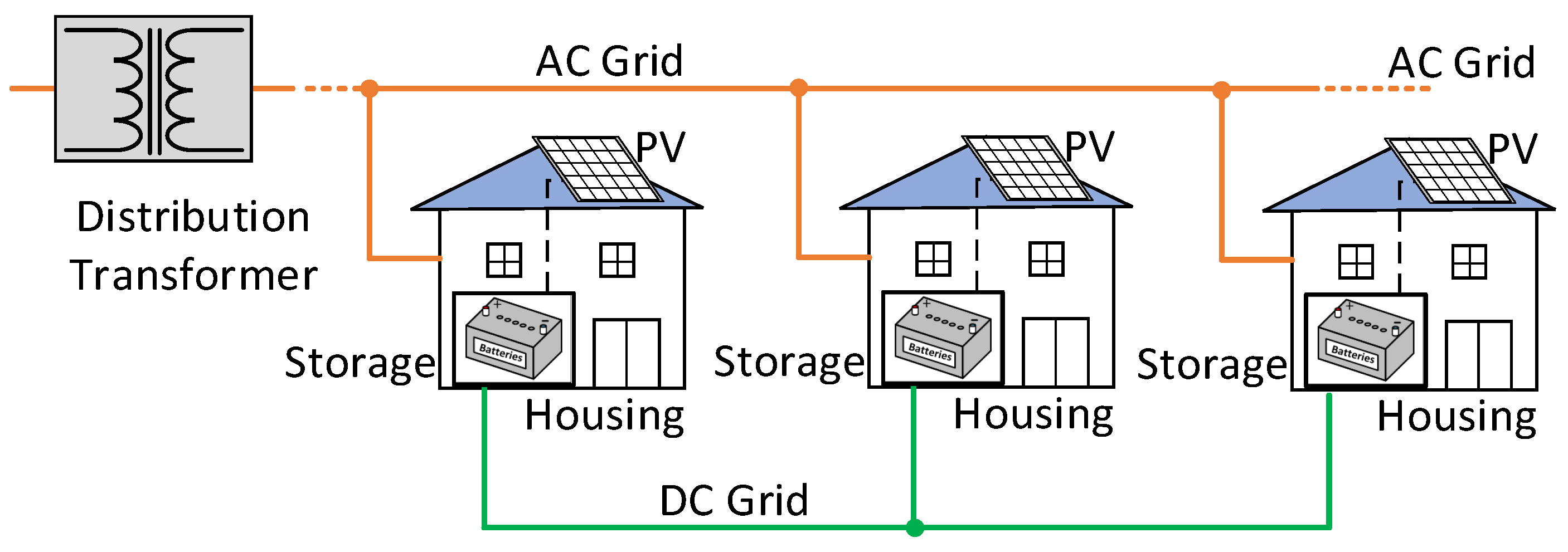
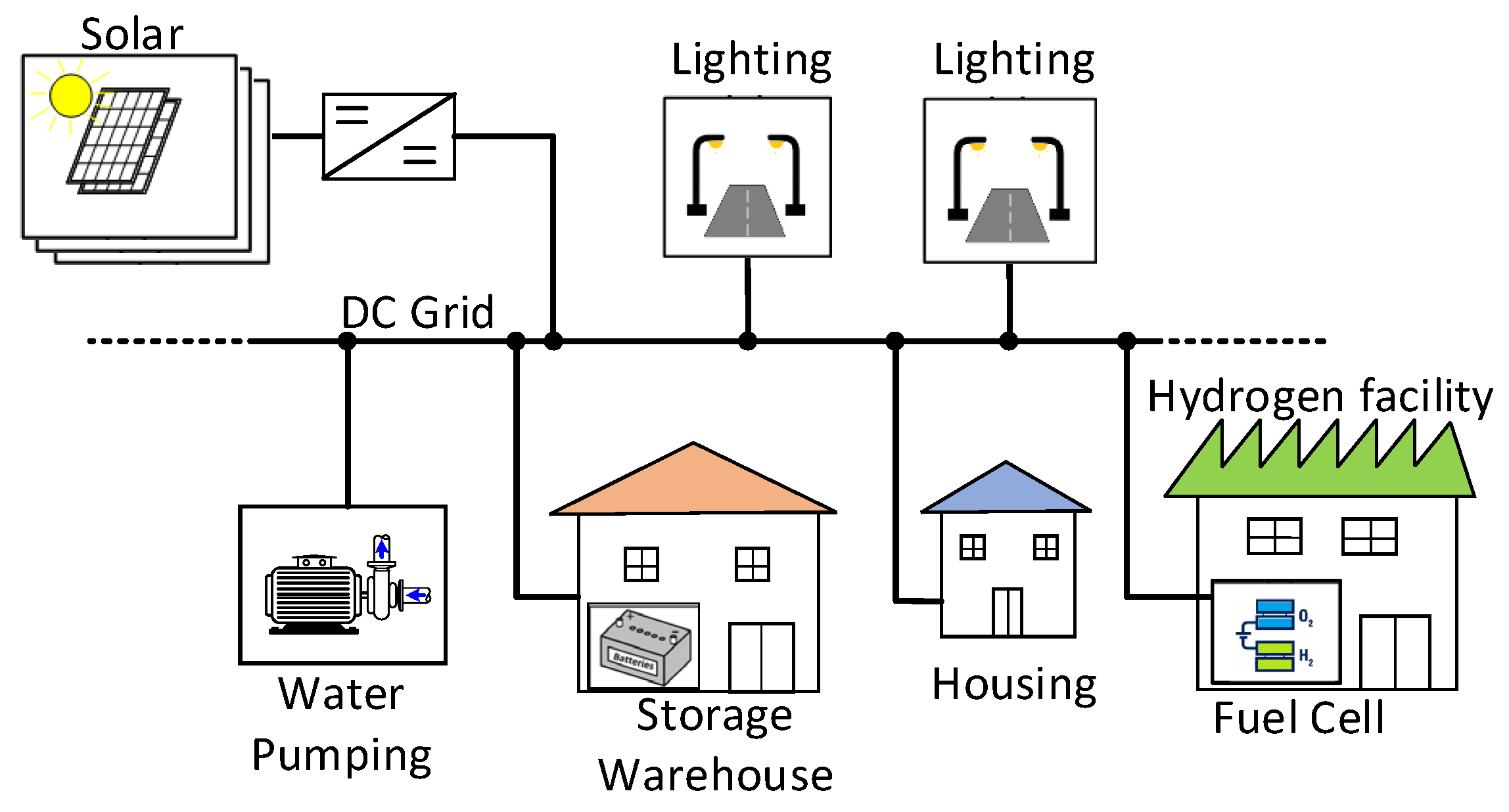
| DC Structures | References |
|---|---|
| Single bus topology | [2,17,18,19,20,21,22,23,24,25,26,28,29,30] |
| Radial topology | [2,17,18,19,20,21,22,23,31,32,33,34,35] |
| Ring or loop | [2,17,18,19,20,21,22,23,36,37,38,39] |
| Mesh topology | [2,17,18,19,20,21,22,23,31,32,33,40,41,42] |
| Interconnected topology | [2,17,18,19,20,21,22,23,43,44] |
| DC Structures | References |
|---|---|
| Unipolar configuration | [45,46,47,48,49,50,51] |
| Bipolar configuration | [45,46,47,52,53,54,55,56,57,58,59] |
| AC Microgrid | DC Microgrid | |
|---|---|---|
| Direct integration of the RES (such as PVs) with the need for a DC/AC converter | No | Yes |
| Direct integration of the ESS with the need for a DC/AC converter | No | Yes |
| Direct integration of DC loads | No | Yes |
| Power quality and control of the MGs | Complex | Easy |
| Need for synchronization | Yes | No |
| Frequency regulation | Constant, equal to 50 or 60 Hz | No |
| Skin effect | Yes | No |
| System protection | Fully developed, not expensive | Underdeveloped, expensive |
| Standards | Sufficient | Insufficient |
| Cost of the system | Low | High |
| Possible Applications | References |
|---|---|
| Electric vehicles charging systems infrastructures | [64,65,66,67,68,69,70,71,72,73] |
| DC infrastructure in which an interconnection between a Medium-Voltage DC grid and a Low-Voltage DC grid is used | Vision of the authors |
| Electrical infrastructure for individual residential level | [74,75,76,77,78,79] |
| Electrical infrastructure for buildings | [80,81,82], Vision of the authors |
| Parallel AC and DC infrastructure at level of LV electrical networks | Vision of the authors |
| Isolated DC infrastructure in a rural context | [32,85,86,87,88] |
| Ships | [89,90,91,92,93,94] |
| Trains | [95,96,97,98] |
| Data Centers | [99,100] |
Disclaimer/Publisher’s Note: The statements, opinions and data contained in all publications are solely those of the individual author(s) and contributor(s) and not of MDPI and/or the editor(s). MDPI and/or the editor(s) disclaim responsibility for any injury to people or property resulting from any ideas, methods, instructions or products referred to in the content. |
© 2023 by the authors. Licensee MDPI, Basel, Switzerland. This article is an open access article distributed under the terms and conditions of the Creative Commons Attribution (CC BY) license (https://creativecommons.org/licenses/by/4.0/).
Share and Cite
Pires, V.F.; Pires, A.; Cordeiro, A. DC Microgrids: Benefits, Architectures, Perspectives and Challenges. Energies 2023, 16, 1217. https://doi.org/10.3390/en16031217
Pires VF, Pires A, Cordeiro A. DC Microgrids: Benefits, Architectures, Perspectives and Challenges. Energies. 2023; 16(3):1217. https://doi.org/10.3390/en16031217
Chicago/Turabian StylePires, Vitor Fernão, Armando Pires, and Armando Cordeiro. 2023. "DC Microgrids: Benefits, Architectures, Perspectives and Challenges" Energies 16, no. 3: 1217. https://doi.org/10.3390/en16031217
APA StylePires, V. F., Pires, A., & Cordeiro, A. (2023). DC Microgrids: Benefits, Architectures, Perspectives and Challenges. Energies, 16(3), 1217. https://doi.org/10.3390/en16031217







